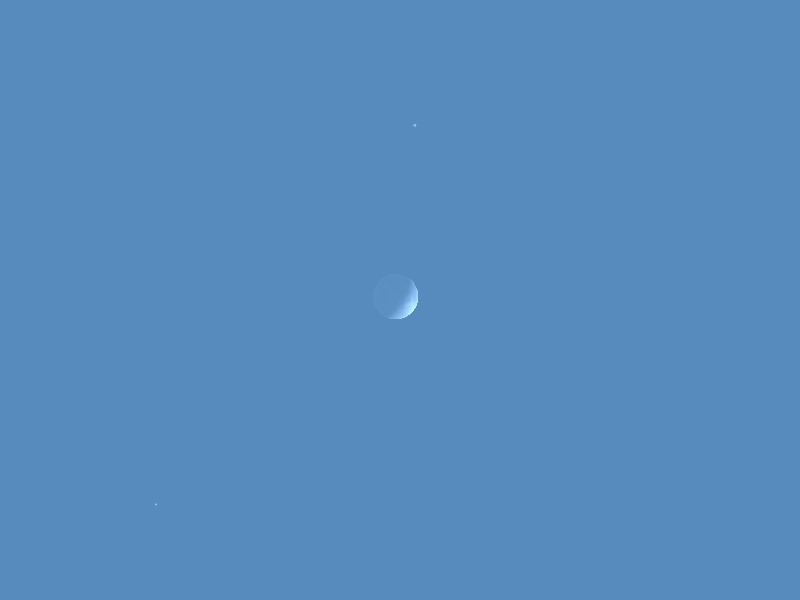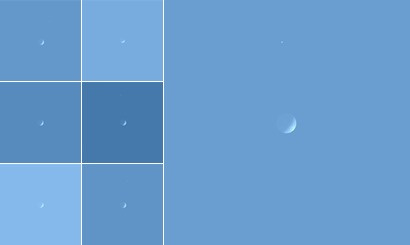March 17 and 18, 2013 provide opportunities to view the bright planet Jupiter near the waxing crescent moon in a daytime sky. The post below – describing the details of this kind of viewing and offering advice on how to do it – is reprinted with permission from Larry Sessions of the Starman’s Meanderings blog.
Not many know it and fewer have actually done it, but the planet Jupiter can be observed in the daylight sky under good conditions… with the unaided eye. Most everyone knows that the Moon can sometimes be seen in full daylight, and most amateur astronomers have glimpsed Venus once or twice with the sun still in the sky.

Some have even reported observing the bright star Sirius in the daytime sky, although I have to say that if this is true, if must have been as a result of exceptional eyesight under remarkable atmospheric circumstances. In fact the academic studies I have read relating to the daytime observation of stars strongly suggested that no star is bright enough to be seen in the daylight without optical aid. Based on my experience I think this is true.
Three planets, however, can be seen if the conditions are right. They are Venus, Mars and Jupiter. Venus is not much of a challenge, and in fact is pretty easy if you know when and where to look. However, even at their brightest, Mars and Jupiter are only about one-sixth as bright as Venus and present significantly greater difficulty. Seeing Mars with the unaided eye in the daytime is not going to be reasonably possible for some time, so let’s just consider Jupiter.
If you have reasonably good eyesight, and know when and where to look, you can join a very small group of observers who have caught the giant planet in broad daylight, without a telescope. Although I have yet to observe Mars in the daytime (haven’t actually tried), I have clearly and distinctly observed Jupiter 3 times in daylight over the same number of decades.
So how do you do it? As with many things, it’s all about timing. First and foremost, you must find a time when Jupiter is as high in the sky as possible just before sunset. In general the sky is not as bright in late afternoon as it is at midday, so Jupiter will stand out better in contrast. Being as high in the sky as possible ensures that Jupiter’s light passes through the smallest column of air before it reaches your eyes, minimizing absorption of its light. Essentially, what this means is that what you want to do is choose a time of year when the ecliptic is highest in the sky at sunset (which is in the spring) and when the sun and Jupiter are in “quadrature,” which is just a fancy way of saying that the two are separated by 90 degrees (or 270 degrees) in the sky. These conditions are met best during one spring every 12 years. (The years before and after are possible, too, those not as easy.)
As it turns out, March 2013 offers the best chance for the next 12 years. (Again, not the only chance, mind you, but the best.)
Now, to make it even easier, it would be nice to have a “landmark” in the sky to help you locate Jupiter. Enter the moon, stage right. As it turns out, the moon’s trajectory in the sky is very similar to Jupiter’s, so we need to pick a time when the moon passes near Jupiter shortly before sunset.
All these factors come together this weekend, when the nearly first quarter moon passes near Jupiter, high in the southern sky shortly before sunset. Of course the moon will be near Jupiter all night until they set around midnight, but you want to view in, say, the last half hour before sunset. Saturday, Sunday and Monday will do, but Sunday (3/17/2013) is by far the best day this time around.
See a chart showing Jupiter near the moon in the March 17 night sky here
Before observing, it’s ideal if you can get a star chart showing the position of the moon and Jupiter at the time you want to observe. You can get these in many software products, including a number that are free. (The graphic near the top of this page shows the moon with Jupiter as a tiny speck above it, facing roughly south at about 6:30 p.m. Sunday as viewed from Denver. A graphic for several other cities is below.)
Stand somewhere with a clear view of the southern sky, but out of direct sunlight or strong reflections. It may help to “cup” your eyes or use some other method to reduce the excess light. Then locate the crescent moon in the southern sky at around 6:30 pm local time and scan the area with binoculars. Once you find Jupiter in the binocs, try it with just your eyes.
The previously mentioned image near the top of this page is a screen save from Starry Night software showing the moon and Jupiter (small dot above the moon) set for Sunday afternoon at about 6:30 p.m. as seen from Denver.
Here are screen saves for several U.S. cities (view as slideshow to see city names):

We have considered only late afternoon observations here, but similar reasoning holds for early morning observations. In fact, early morning observations are even easier in a sense because you can observe Jupiter or Mars before sunrise, then track it into the daytime sky. But for this time around, it is afternoon observations only.
Of course, if you have a “go to” telescope you can just find Jupiter that way, and then attempt an unaided eye observation. But frankly, I think that this is kind of copping out. Still, use a crutch if you must.
For more, see my article on EarthSky.org:
10 surprising space objects to see in the daytime sky
Bottom line from EarthSky editor: Here’s an awesome daytime observation. It will be possible to view the bright planet Jupiter in a daytime sky on Sunday, March 17 and Monday, March 18. Locate the moon high in the sky before sunset. Scan near it for Jupiter. This post contains graphics showing Jupiter’s location near the moon on Sunday, for various U.S. cities.











